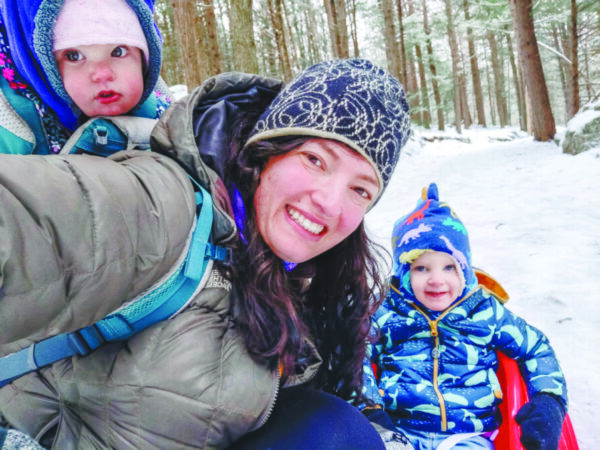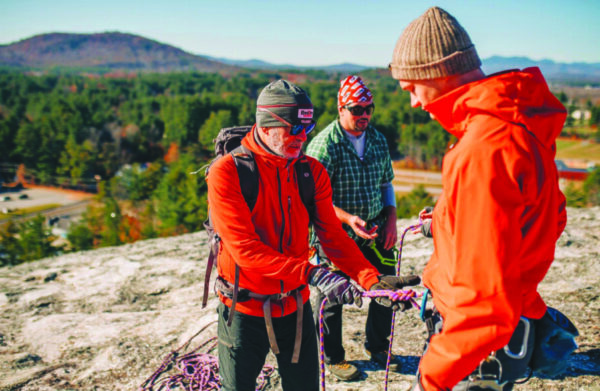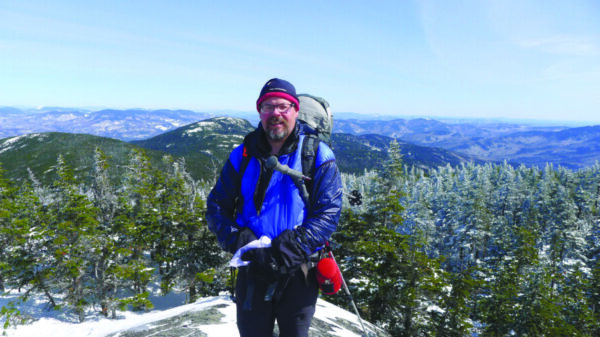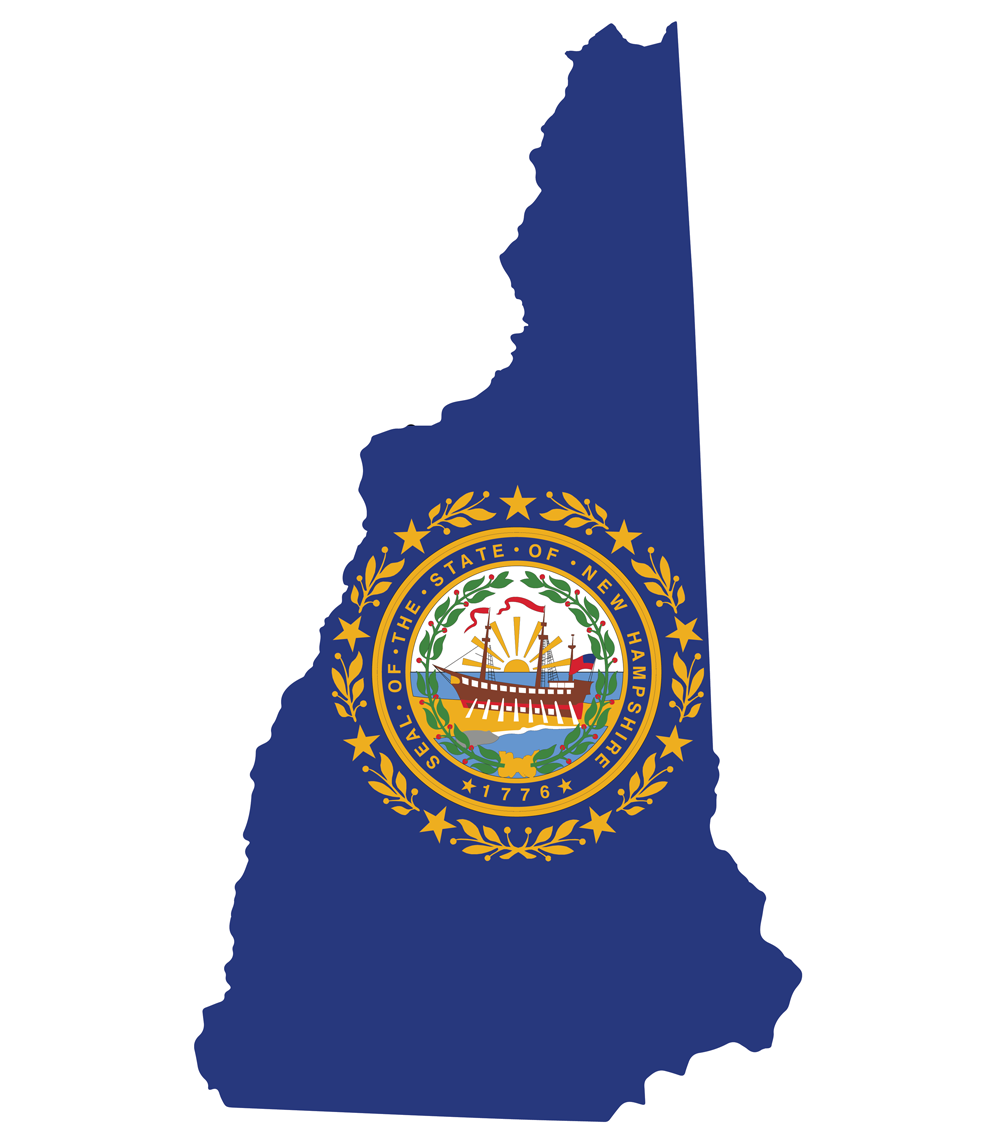How to stay safe and warm while exploring NH’s winter wonderland
By Dan Szczesny
At just over 2,300 feet, Belknap Mountain in Gilford is a hill compared to its cousins up north in the White Mountains. But every mountain in New Hampshire presents hikers with unique challenges, especially in the winter.
Add a little hiker into the mix — in this case 2-year-old Oren Driscoll — and tiny Belknap Mountain can suddenly seem as large as Mount Everest.
Young Oren had just finished exploring the active Fire Tower at the summit and he and his mom, Epsom writer and veteran hiker Allison Driscoll, were relaxing with lunch near the base of the tower. Like many of the fire towers in New Hampshire, the open grating and steep stairs can be tricky to even the most weathered explorer.
Not to Oren, though, according to the older Driscoll.
“He’s not a daredevil kind of hiker,” Driscoll said. “So he was pretty proud of himself.”
A few minutes later, a much older kid showed up at the summit but was too afraid to go up the tower. This was a big moment for Oren, and for his mom.
“It was interesting to watch a 2-year-old make that climb when a 10-year-old couldn’t,” Driscoll said. “That was a little bit of an a-ha moment for me, when we started to think that we were on the right track.”
Driscoll is the administrator of the popular Trail to Summit website (trailtosummit.com), a resource for trip reports, recipes, gear reviews and stories about inspirational female hikers. But even for a long-time experienced hiker like Driscoll, the hiking world changed when kids entered the equation. Add the treacheries of winter into the hike planning, and everyone suddenly becomes a beginner.
“It becomes about different expectations,” Driscoll said.

With the fall shoulder season firmly in the rear-view mirror and a pandemic still making normal winter indoor activities a challenge, more and more new hikers and families are looking to the enormous number of parks, mountains and trails in New Hampshire to get outside. But winter hiking requires a bit more patience, planning and, in some cases, skill.
“When you’re new to the hiking world, especially in the winter, people don’t know the difference between mountains and not mountains,” said Mike Cherim, owner of Redline Guiding (redlineguiding.com). “Your first step is to know what you’re doing so you can maximize your winter hiking experience.”
Cherim’s company, located in Intervale, specializes in matching hiking guides and routes with hikers, whether that be experienced pros looking to climb technical routes up icy mountains or a family of beginners learning how to snowshoe for the first time.
“There’s an expression we use,” Cherim said. “Mountains spare most fools.”
The key word there, of course, is “most.”
I set out to discover the process of turning a brand-new hiker (or a new family of hikers) into a confident and safe New Hampshire winter explorer. It all comes down to the acronym GPS: gear, preparation and selection.
Having the proper gear
Winter hiking, whether on a big exposed mountain or a close-to-home rail trail, is about two things: staying warm and regulating your body temperature. That goes for hikers of all ages, even kids. So the first step is to learn about layering.
“Winter hiking generates an enormous amount of body heat,” said Bartlett-based gear guru Philip Werner. “When perspiration dries, it’s transformed into vapor and pulls the heat out of your body.”
Layering allows you to regulate your perspiration and body temperature by literally taking off and putting on different layers of clothing throughout your hike. The key is regulation, Werner said.
The hiking expert and adventure writer is the owner of Section Hiker (sectionhiker.com), a hiking company that focuses on gear, ultralight backpacking and White Mountain treks.
“It’s counter-intuitive, but when you’re perspiring, take off your outer clothes,” he said. “You’ll actually be warmer.”
The best way to regulate your body temperature through layering is to practice off-hike first — maybe try out your layers in your backyard shoveling snow, for example. There are some general rules of thumb: base layer, fleece layer and heavy layer. The heavy layer (ski jacket, down etc.) is best for standing still, above tree line, or in heavy winds or a storm. For below the waist, a base layer and either fleece or shell pants or ski pants to mostly be enough. Again, in general, you don’t remove pants layers like you would torso layers.
Once you’ve got your layering strategy down, then it’s time to think about your feet.
“In general, if it’s your first time in winter, you’re going to want some sort of traction,” said Ken MacGray, a hiking writer and editor of the AMC Southern New Hampshire Trail Guide. “Yaktrax might be good for the driveway, but you’ll want to think about microspikes or even crampons — something with beefier teeth — if you’re climbing.”
As the writer of New Hampshire’s 52 With a View: A Hiker’s Guide, MacGray has plenty of experience walking families through the lower mountains that are part of that list.
“Southern New Hampshire has its share of really difficult trails,” he said. “For winter hiking, if the cold bothers you, you just won’t want to be doing this.”
Finding ways to not just deal with but thrive in the cold is an important first step to enjoying winter hiking. In the case of new or first-time families, a layering strategy may even take a back seat to straight up keeping tightly bundled.
“My daughter is strapped onto my back,” said Allison Driscoll, referring to her other child, nearly 2-year-old Lyra. “She’s stationary when we’re out there so we need to make sure she’s very insulated.”
Some other gear tips suggested by the experts include figuring out exactly what type of winter activity you or your family want to experience. Gear for a winter hike is different from gear for a cross-country ski, or for snowshoeing. Even the terrain you’ll be hiking on can lead to different gear decisions. And that leads to the next step of GPS: preparation.
Being properly prepared
Preparation is Mike Cherim’s business. Literally.
For the past five years Cherim and the dozen active guides on his roster have been not only guiding but training and teaching as well.

“We’re willing to take anybody and teach them the ropes and get them to where they want to be,” Cherim said. “A guide can bring so much to the table, not just facts, but putting things into perspective, giving some history, that sort of thing.”
Cherim was 4 years old when he hiked Mount Washington for the first time with his hiking-loving parents, and the hiking bug has been with him ever since.
But even if you’re not preparing for a huge, technical climb, or are not ready for a guide yet, a little bit of advance research into your routes and abilities can go a long way.
All the experts we talked to for this story recommended any beginning winter hiker take a walk through the many outdoor gear stores in the area (think acronyms, EMS, REI, IME) and talk to the store clerks, many of whom have winter hiking experience.
Werner suggested getting some practice with new, expensive gear by renting it first.
“Go to a place that rents gear and has groomed winter trails,” he said. “That’s a good way to experience snow for the first time. Or how about tubing or sledding as a first encounter ― there’s lots of overlap with hiking there.”
One particular group of first-time hikers ― kids ― may be challenging to hike with, Driscoll said. She hiked a lot, even when pregnant, but with her kids some of that preparation is mental.
“Being outdoors is so important for brain development and regulating emotions for kids,” she said. “Preparation sometimes consists of adapting to a new mindset.”
Finally, for a large swath of potential first-time hikers in southern New Hampshire, a great first snow hike could be on a rail trail (nhrtc.org). The state has close to 400 miles of rail trails to offer hikers, said Paula Bedard of the New Hampshire Rail Trails Coalition.
The nonprofit organization is designed to support and promote the dozens of rail trail organizations, friends groups and user groups throughout the state.
“What we’re trying to do is provide a forum where all groups can get together to share success stories and strategies,” she said.
With about 50 different rail trails throughout the state, the coalition plays a big role in the final key to hiking: selection.
Selecting the proper hike
Rail trails are virtually everywhere in New Hampshire. Most have easy access and parking and are generally flat and well-graded. Several, like the Goffstown, Derry and Piscataquog rail trails, offer miles of wide open scenic trail use right in the backyard of some of the most populated sections of the state.
“Every time I pull into my street, I can see people using the trail,” said Paula Bedard, who lives in Goffstown. “There’s been a huge uptick in usage [since the pandemic began] and it’s just continuing to grow. People are discovering rail trails they would not have otherwise.”
MacGray agreed that finding local trails nearby is a great first step toward tackling the higher hills. Rail trails aren’t included in the Southern New Hampshire Trail Guide, but plenty of smaller options are.
“There’s huge advantages to winter hiking,” he said. “No bugs, no moisture in the air, so better views and rocks covered up to make climbing easier.”
How to plan that first hike? For a first-timer in good shape, on a flat surface — say a rail trail — in normal winter conditions (not a blizzard), pick a trail that is 2 to 4 miles out and back. If you’re going up a mountain loop, or above tree line, stick to 1 to 3 miles. As for temperatures, for a first-timer with the right gear there’s really no limit; 0 is the same as 30. More importantly, you want to look at wind chill, storms, etc. It can be 20 degrees but the wind chill can make it feel like -20. That’s the important factor.
Family-friendly state parks in the southern part of the state to select for your first winter hike include Bear Brook, Pawtuckaway and Pisgah, MacGray said.
“There’s plenty of challenging, remote trails there for sure,” he said. “But many trails there are old roads so they are wide and generally not steep.”
Werner added one more reason to select winter hiking ― the wild life.
“There’s animal tracks, songbirds are out and there’s plenty of apps you can download and then just hold up to help you identify,” he said.
Driscoll agreed and recalled the first time on a winter hike that her son was visited by a gray jay, a large songbird that has a habit of feeding right out of hikers’ hands.
As for selecting new hikes, Driscoll said she and her son are now pursuing the state fire tower list, a collection of short hikes to active lookouts around the state.
“Lists add incentive for kids,” she said. “We just want to make sure it’s fun.”
Get outside and hike!
We asked the experts to recommend some fast, easy and family-friendly hikes in southern New Hampshire. They came up with a diverse and sometimes off-the-beaten-path list. Remember, even on a flat, easy trail, winter hiking can present challenges. Make sure you bring the proper gear for the weather and mind leave-no-trace etiquette on all trails and parks.
Paula Bedard
nhrtc.org
Goffstown Rail Trail, Goffstown: This 5.5-mile quiet, flat former rail bed runs through Pinardville, Grasmere and Goffstown Village. Voted one of the top 10 rail trails in New Hampshire by the Rails to Trails Conservancy, the trail’s hardpack surface is perfect for cross-country skiing or snowshoeing in the winter. The trail’s southern end connects up with Manchester Piscataquog Rail Trail and will take you right into the city.
Features: The Goffstown Rail Trail primarily follows the Piscataquog River and features excellent views of Glen and Namaske lakes. The trail is also a popular geocache area, with several caches hidden along its route. The trail is maintained by the Friends of the Goffstown Rail Trail, so signage and kiosks can be found all along the way.
If you go: The trail more or less follows Mast Road and South Mast Road for most of the route, and dedicated parking for the trail can be found at a couple spots along the way, including off Danis Park Road and Moose Club Park Road. If coming from Manchester, you can also park down by West Side Arena off Electric Street at the Piscatoquog Boat Ramp, and cross the bridge to the southern start of the trail.
Allison Driscoll
trailstosummit.com
Marjory Swope Park trails, Concord: Marjory Swope Park is a fairly new hidden gem in east Concord, entrusted to the city in 2012 by John Swope, who named it after his wife. The primary trail is the Blue Loop, a 1.4-mile trail that circles the park. The Yellow Trail bisects the Blue Loop and goes up and over the top of Jerry Hill.
Features: The park features the remains of an old fire tower at the height of land in the park on Jerry Hill. The primary feature of the park, however, is Gilfillan Rock (featured in the “NH Rocks That Rock” field guide), a large rock ledge inscribed with dozens of names of hikers and students of nearby St. Paul’s School dating back 125 years.
If you go: Primary access to the Blue Loop and a small parking area can be found on Long Pond Road just north of Route 202.
Mike Cherim
redlineguiding.com
Mount Kearsarge, Wilmot from the north, Warner from the south: One of the jewels of the state park system, Mount Kearsarge can be reached from either Rollins State Park to the south or Winslow State Park to the north. This nearly 3,000-foot mountain may be located south of the White Mountains, but its bare summit and trail mileage can make it as difficult a hike as some of its northern cousins. It all depends on the weather.
Features: The main feature that makes Mount Kearsarge such a popular destination is its bare summit and tremendous 360-degree views from the top. There’s also an active fire tower up there. But the state parks at the southern and northern base of the mountain are lovely destinations in and of themselves for beginning winter adventurers looking to try snowshoeing or cross-country skiing for the first time.
If you go: From the north, Winslow State Park can be reached at 475 Kearsarge Mountain Road, Wilmot. Rollins State Park can be reached at 1066 Kearsarge Mountain Road, Warner. In both cases, during the winter, a road walk is required to reach the main park areas, but those are great places to break out the snowshoes and skis. We recommend checking ahead and keeping an eye on the weather.
Ken MacGray
kenmacgray.org
Nottingcook Forest, Bow: Nottingcook Forest is a large forest easement held by Bow Open Space that offers a series of criss-crossing and unique trails through the streams and runoffs surrounding Great Meadow Pond. In general the trails here are easy and perfect for winter outings.
Features: In addition to terrific views from the summit of Great Hill, the forest area features a number of interesting destinations, including Buffalo Rock, Six Acre Swamp, Duckbill Ledge and Steer Brook Gorge. Any of those destinations is no more than a 1- to 2-mile round-trip hike.
If you go: There are three primary trailhead/parking areas for Nottingcook Forest: South Bow Road, Crescent Drive and Woodhill Hooksett Road across from Hornbeam Swamp. Check the forest map beforehand to see which entrance gets you closest to the feature you’d like to visit.

Philip Werner
sectionhiker.com
Hedgehog Mountain, Albany: This small mountain (2,532 feet) is nonetheless a challenging winter hike. Once you’re comfortable with your winter gear and are ready to tackle a more significant hike, try the only mountain on our list in the White Mountains. This nearly 5-mile loop will test you!
Features: Hedgehog commands better views than many much higher mountains, including a stupendous view of nearby Mount Passaconaway. From the mountain’s east ledges you’ll find some of the best views of the Sandwich Range Wilderness to be had. Remember, this is not a flat hike. But it’s a great way to put all your winter training on flat trails to good use.
If you go: The trailhead and parking area are on Kancamagus Highway. The parking area is on the south side of the road, 21 miles east of Interstate 93 at Exit 32 in Lincoln and 14.2 miles west of Route 16 in Conway. It is signed for Downes Brook, UNH and Mt. Potash trails.
Featured photo: Hiking writer and gear expert Philip Werner stops for a break near Mount Garfield during a recent winter hike. Among his gear choices for this hike are softshell pants, single layer insulated gloves, a thin wool base layer shirt, high gaiters. Photo courtesy of LaBelle Winery.





